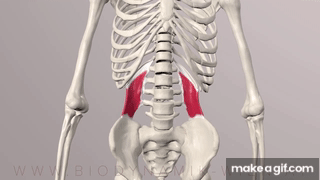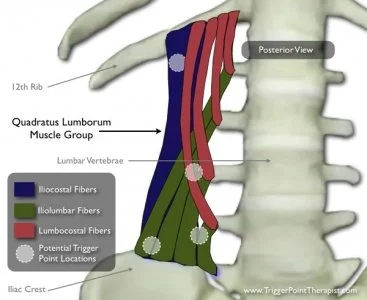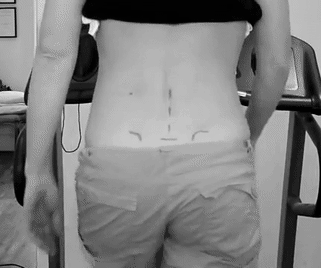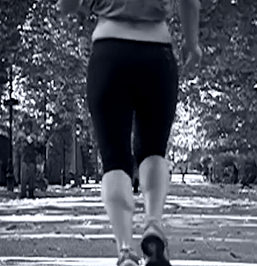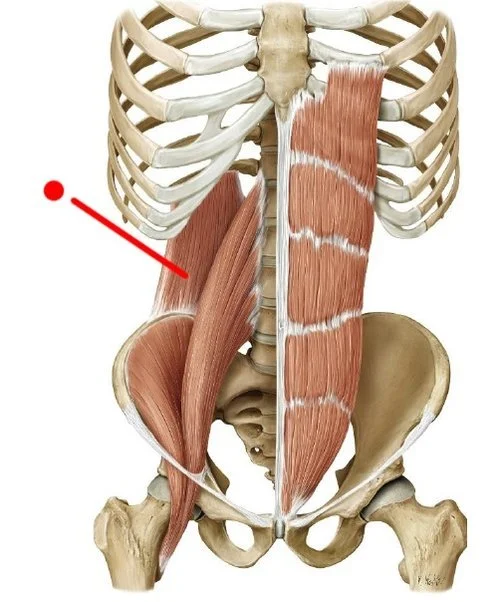Quadratus Lumborum
Ah, yes, the Quadratus Lumborum. Another muscle that sounds like a Harry Potter spell. Apparently, people in the know call it the "QL," but we can start by calling it the quadratus lumborum because the name does teach us a bit about the muscle. Quad, meaning four, refers to the roughly 4-sided rectangular shape of the muscle, followed by lumborum which is technically a reference to "the loins" but we all know this as the lower back.
...And with that just about sums it all up, right??? If you know the shape and orientation of a muscle plus its location, you've got everything you need to understand its function!!!
Look how deep the QL is compared to the other spine and core muscles.
Just to make things more complex, you can see the QL actually has multiple fiber groups that do multiple actions. Based on the points of attachment there are really three different groups with slightly different functions. Amazing.
But just to fill the space, I'll give you an overview anyway. One of the curiosities of this muscle is trying to label the muscle's origin and insertion, the two points of connection to the skeletal system. The origin is usually the attachment closest to the core or axial skeleton while the insertion is usually distal or further away from the center of the body. Unfortunately, however, this is not universally true because some definitions of origin and insertion refer to the origin of the muscle as being the more fixed position while the insertion is one the moving part of the limb or body. Think of doing a biceps brachii curl. Here the origin of the biceps is at the shoulder while the insertion is at the forearm. You could, however, flip things around when doing a chin-up and call the origin of the biceps at the forearm because this is the stable/unmoving part while the shoulder is the insertion moving up and down, but this is just confusing and silly. Most texts and references just refer to the origin as being closer to the center of the body and the insertion further away. Whew.
Getting back to the problem at hand, what is the origin and insertion of the quadratus lumborum? As you can see it grabs on to the 12th rib and a few of the spinous processes of the lumbar vertebrae at one end and goes down to the iliac crest of the pelvis at the other. In my mind, this arrangement would point towards the origin being on the 12th rib and spine with the insertion being on the iliac crest, but Wikipedia and Physiopedia just don't see it that way. They call the origin the iliac crest with an insertion on the 12th rib and transverse processes. Well, it seems like those sources are following the later definition of origin and insertion with the pelvis usually remaining mostly stable in upright movement while the spine moves. This also give the impression that the quadratus lumborum (let's call it the QL now) is a low back stabilizer, and that is exactly what it is.
Function
Well, congratulations for making it through all that text because, labels aside, the real function of a muscle is to contract (in one of three ways) to affect its attachment points. Classically, when we think of a muscle contracting we are thinking of concentric contraction bringing the two attachment points closer together. You can do this with the QL by tilting your pelvis to one side like you are to trying to touch your iliac crest to your ribs, but there are also isometric and eccentric contractions that can occur as well. In regards to the QL, the isometric contraction is very important to its function. Here the QL is stabilizing the pelvis and lower back like the suspension on a car. The pelvis would excessively tilt from side to side with every stride (that sounds like a song), butt it doesn't move (very much) partly due to the QL stabilizing through an isometric contraction.
Don't get me wrong, a little bit of lateral pelvic tilt each time your body weight shifts is not bad. In fact, you'll need to master this if you want to get your supermodel walk down pat. Your car's suspension doesn't stop all movement, it just dampens it. Same here, your QL takes some of that jarring load off the bones of your hips and spine by absorbing some of the energy.
In fact, it's really amazing that you can walk or run fluidly transitioning all of your body weight (and more if you're sprinting and really pushing off the ground) from one leg to the other without your pelvis getting out of whack. Think of all that energy pushing up from your foot through your leg to your pelvis every time your foot hits the ground, plus all that body weight above the pelvis coming down only supported by the freely moving lumbar spine!!! The rigid pelvis is attached to this column of bone that can move in every direction, yet the whole unit stays surprisingly solid when you're walking around. It really makes you appreciate all of those core muscles for more than just their ability to do sit-ups.
Which brings us, in a roundabout way, to the the final type of contraction, the eccentric contraction, where the QL is lengthening in a controlled manner while firing. This is best seen in that dampening effect that the QL can have while running. When the right foot plants the left side of the pelvis wants to drop down because no leg is supporting it. The QL can contract (with other muscles) to keep that hip from dropping too much by eccentrically contracting to give a little bit of hip drop but not too much. This "just right" wiggle of the hips is seen above, and is natural, leading to a nice smooth stride instead of that stiff, jarring run that we spoke of earlier.
In addition to these side to side contractions leading to lateral pelvis movement, because QL is in the back and inserts (or originates) from the posteior iliac crest), concentric contraction can also tip the front of the pelvis down and further arch the lumbar spine. Chances are, like me, you just did this motion sitting or standing and you can feel your QL and erector spinae muscle contract in the lumbar area. Good job! Thats another function of the QL, essentially opposing the contraction of the more famous rectus abdominus that wants to pull the front of the pelvis up to the sternum. In another cool isometric contraction, the pelvis will remain very stable if the muscles on the anterior and posterior aspect contract together.
Speaking of core muscles, above are pictures of just a few of the muscles that work with the QL to stabilize the pelvis/spine. It certainly does not function alone when moving or stabilizing the pelvis and spine. Given the complexity of movement even in everyday walking we discussed above it is no wonder that the QL is subject to injury and may cause pain. A couple of videos below talk about this pain and the idea that the QL might "shorten" over time if left in a particular position. I think this is more of a bad habit with continuous over or under-reliance on the muscle to do its job.
Exercises
As with most muscles of the core, I believe that the best exercises to start with are the isometric contractions such as all the variations on planks that you can do. If your QL is not strong enough to stabilize in a side or regular plank position then certainly it should not be stressed by concentric contraction that actually shorten the muscle. These more advanced concentric actions would, of course, laterally flex the spine in relation to the pelvis and/or cause an exaggerated lumbar curve with an anterior pelvic tilt (that posture we practiced earlier).
Again, a "short" QL is often blamed for this anterior pelvic tilt posture and many videos and websites suggest "release" or massage techniques to combat this poor posture. I think this is part science part voodoo to think that rolling a tennis ball on a muscle is going to "lengthen" the muscle, but rather I think it's retraining the way your muscles contract (or don't contract) that really leads to optimal functioning. It is the neuromuscular training of how and when to contract muscles by good biofeedback. Maybe a tennis ball in the back give the brain enough information to relax and thus lengthen the QL, but I'm not an expert here. My biggest advice in watching or reading any of the advice I give you or otherwise is to to take it with a grain of good anatomy and physiology salt.
Work that QL, girl!
By this time, if you've read all my posts, you will be a muscle expert and can tell the function of the muscle just by looking at its shape. Furthermore, I hope that you can look at some of the latest fitness trends and products (like the latest and greatest "QL contractor" gizmo or exercise) with a critical eye to say whether it is worth all the fuss or time or energy. There are lots of articles and posts and videos on "the importance of the quadratus lumborum" or how to "fix back pain by QL release," but you'll know snake oil when you see it if it doesn't match up with the muscle's true form and function.
Irregardless, of what you think about the opinions of the below therapists and trainers, I think we can all agree that a strong quadratus lumboratum is important not only for good back health, great running form, but most importantly, an exaggerated hip dip that makes you walk like a supermodel!!



